#Qinshihuang
Text

The Young Prince
✸✸✸
Ying Zheng (King of Qin/Qin Shi Huang) from the Da Qin Di Guo (The Qin Empire) novel
(a redraw of an original novel illustration)
213 notes
·
View notes
Text
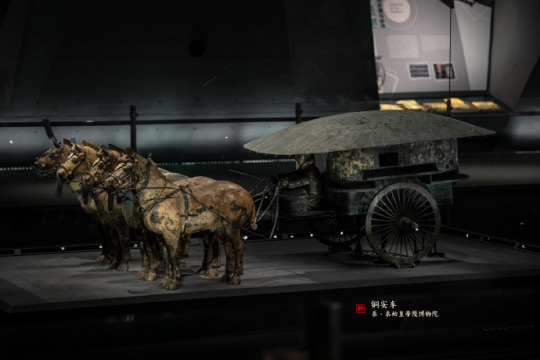

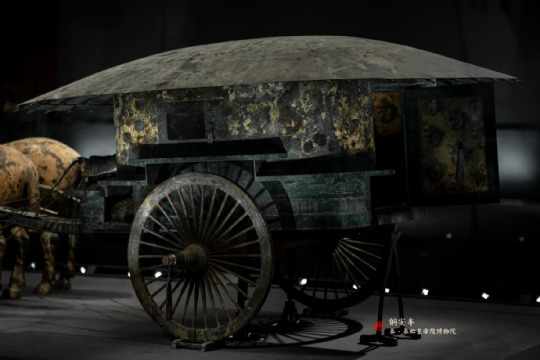




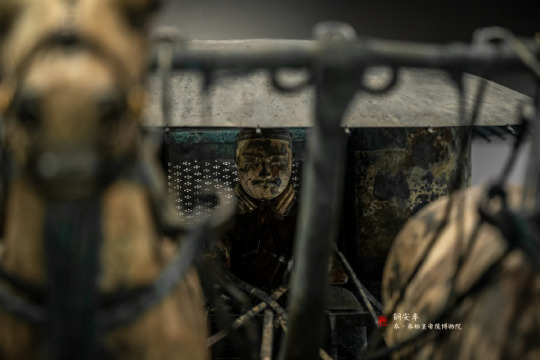

Canopy Chariot From The Emperor Qinshihuang Mausoleum
Qin dynasty chariot, unearthed from the burial pit on the west side of the Qinshihuang Mausoleum (秦始皇陵) in Lintong, Shaanxi.
The life-size painted chariot is 317 cm long and 106.2 cm high. Exhibited in the Emperor Qinshihuang's Mausoleum Site Museum (秦世皇黃陵博物院).
Vintage photos of the excavation and restoration:

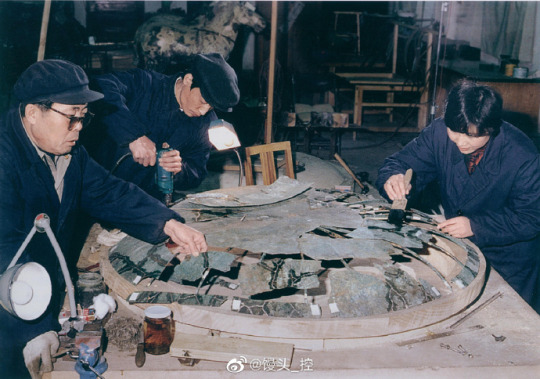

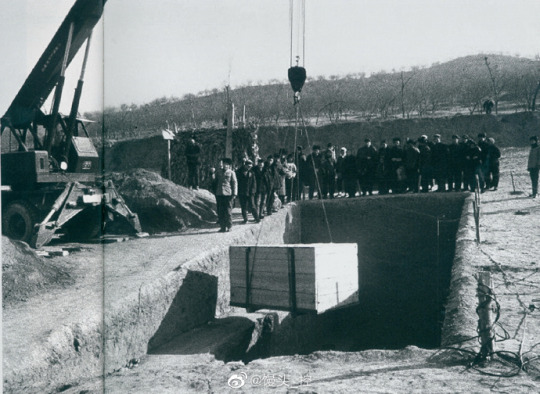


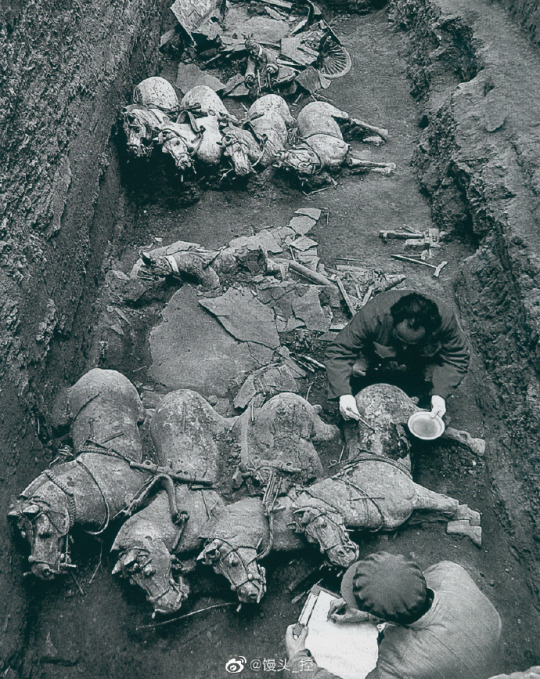
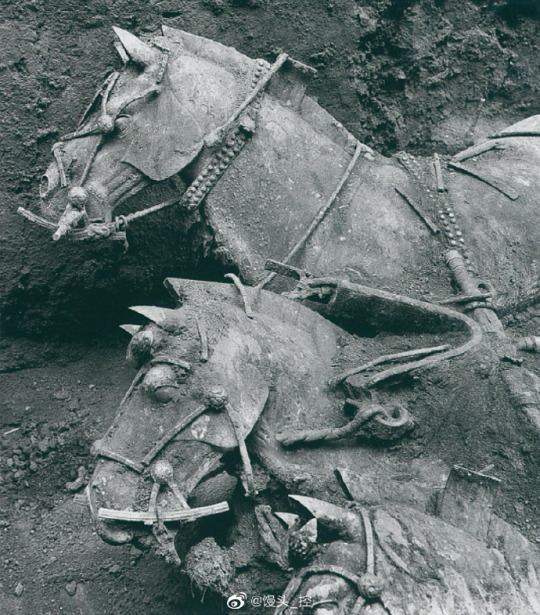
#ancient china#chinese culture#chinese art#chinese history#qin shi huang#chariot#qin dynasty#ancient tomb#archeology#chinese warfare#Terracotta Army#terracotta#mausoleum#tomb art#charioteer
64 notes
·
View notes
Note
ok so. i am very slowly reading through 七爷, and i don't understand what jing beiyuan is the prince of. like, i understand he's in charge of a territory in the south, but does he have additional responsibilities? is he very low but still on the list of people eligible to inherit? he clearly feels a great sense of civic responsibility, but i'm afraid i'm missing something.
hmmmmmmmm this is kind of complicated because there's some weirdness around translation of imperial dynastic titles, which then gets even more confusing when you slap the general ahistorical ambiguity of genre onto things
so I think the confusion occurs because of the conflation of "prince" as a title of rank, "prince" as "son of a monarch," and "prince" as "ruler of a territory." Jing Beiyuan's exact title is 南宁王 Nanning wang, which is usually translated as "the prince of Nanning," though I can't remember if 南宁 Nanning is simply his title as prince or an actual location (if it is a location, it seems not to be particularly plot relevant since I have uhhh no memory of it)
the thing about 王 wang as a title is that it got royally upstaged (ayyy) by Mr. 嬴政 Ying Zheng (aka 秦始皇 Qin Shi Huang / the Qin First Emperor) back in the 3rd century BCE. The reason why we call him "the Qin First Emperor" is because the man literally invented his own title, 皇帝 huangdi, which we now translate as emperor. Prior to that, monarchs were called 王 wang / kings, and during the Warring States period, you had location-specific kings: 楚王 Chu wang / "the king of [the state of] Chu," 吴王 Wu wang / "the king of [the state of] Wu," 齐王 Qi wang / "the king of [the state of] Qi," etc etc. And prior to that, you had the Zhou Dynasty, whose rulers all carried the title of 王 wang: 周文王 Zhou Wen Wang / “King Wen of Zhou” or “the Civil King of Zhou” and 周武王 Zhou Wu Wang / “King Wu of Zhou” or “the Martial King of Zhou” depending on how you translate them, etc. Qinshihuang, in order to declare his dominance in conquering the Central Plains, decided to one-up all of these petty kings by making up a new title for himself that was automatically higher than the rest of the 王 wang, rather than competing for an existing title
the ripple effect from Qinshihuang raising the ceiling on titles/positions in governance meant that everyone could effectively move up one tier. if, in the past, the ruler was called 王 wang and his son 王子 wangzi (literally "son of the king" but often translated as "prince"), then the creation of the new 皇帝 huangdi / "emperor" title meant that the emperor's sons were referred to as either 皇子 huangzi / "son of the emperor" or 王 wang (the distinction between the two is usually one of age). basically, 王 wang goes from meaning "king" to "position just below the emperor in rank." that being said, it looks like the general decision has been to translate 王 wang as “prince” in the imperial context rather than “king,” possibly because in English, we’re used to thinking of princes as inheritors in the same way imperial 王 wang are eligible for inheriting the dragon throne
notably, rulers of other states/countries/civilizations were all referred to as 王 wang, since imperial Chinese cosmology dictated that the emperor ruled all under heaven (ah, imperial hegemony...). there are also tiers of 王 wang, as in 亲王 qin wang and 郡王 jun wang, but let's not get into that now
so! back to Jing Beiyuan. this gets fun because he’s what’s called an 异姓王 yixing wang, lit. “a king/prince of a different surname.” that means that his family is not patrilineally connected to the imperial family (thus, having a different surname), but the title of 王 wang was at some point conferred upon his family. this usually occurs when, say, an emperor decides to reward a general with the title of 王 wang because he’s so pleased with his general’s accomplishments. during the conferral, the emperor will usually specify if this is a title that can be inherited forever or downgraded from generation to generation (i.e. from 王 wang to 侯 hou, and downwards until eventually the family returns to normal non-aristocratic status).
these 异姓王 yixing wang have a lot of power and influence, comparable to a son-of-emperor 王 wang, but not quite the same because they are not of the imperial family and therefore not in line for the throne. imperial princesses sometimes marry into these 异姓王 yixing wang families, but that can be a recipe for disaster because it begins to make that bloodline — well, not exactly eligible for the throne, but certainly more eligible than they were previously, and if there is one trait you can trust a dynastic emperor to have, it’s the paranoia about potential coups by powerful relatives (but is it paranoia if it really is true? anyway)
all that is to say — I don’t think Jing Beiyuan is the prince of anything in particular, though as a landed aristocrat I’m sure there are fiefdoms in his name. I can’t remember off the top of my head how his family earned the title of Nanning (or if it’s ever explained in the novel), but if I had to guess, I’d say that some ancestor of his was an accomplished general who had the title of 南宁 Nanning (which has the valence of “to bring peace to the south”) conferred upon him, which has subsequently been passed down through the family until it landed on his unfortunate head
250 notes
·
View notes
Text



quick sketch. God-Emperor trio.
EoM from Warhammer series. Leto II from Dune. QinShiHuang from Fate/Grand Order.

71 notes
·
View notes
Text
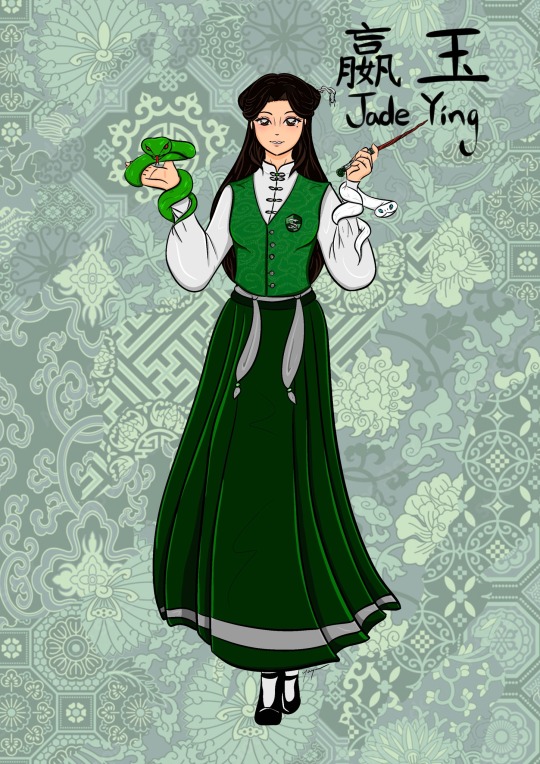
Finally did art of my MC, Jade Ying. Her Chinese name is 嬴玉 (Yíng Yù). She is descendant of the first emperor, QinShiHuang.
She is the oldest child of her family and has a young twin brother, Jasper.
She has two familiars. A green pit viper named XiaoQing and an albino suzhen krait named XiaoBai. Both she raised from their hatching. They are highly venomous but Jade uses their venom in potions and remedies.
At Hogwarts they join her. But since snakes are not part of the acceptable pets, she keeps them transfigured as a hairpin that she always wears. (Ominis hears whispers when in her vicinity but doesn’t know why…yet)
Because she raised her little smallest and have bonded with them. She can hear parseltongue but cannot understand it. But she understands the intent of it.
Her uniform is a mix of traditional Chinese garments and the Hogwarts uniform. She wears a mamianqun skirt, an ao pipa sleeve top, and the elegant vest with the emerald silk robe print.
Will probably do a post of Jade’s history and backstory in the future. But right now I’m just so happy to finally show her to you guys ❤️❤️❤️
7 notes
·
View notes
Note
Okay just dumping some genshin witch ideas, you don’t have to use them this is just for my autism. I apologize for the strange “natures”, I’m just fond of the stranger ones.
Zhongli Witch - Qinshihuang
The antique witch. His nature is torpor. Everything, no matter how seemingly indestructible will eventually become dust. That is something this witch is painfully aware of. Within his barrier, time does not pass and the many antiques and treasures within will remain gleaming forevermore. The witch detests any form of change as it is a sign that time will tick forward once more and threaten his collection. If he senses an intruder, he will stop at nothing to hunt them down and swiftly petrify them. When this witch perishes, everything in the barrier will become dust.
Rukkadevata - Uma
The witch of hanging gardens. Her nature is samudaya*. A benevolent and caring witch, she spends every waking hour building a paradise upon the ever growing tree that makes up her body. She collects knowledge via digging her roots into the subconscious minds of her victims and uses them to improve her heaven on earth, although leaving her victims husks if their former selves. If someone were to wander into her barrier, she would show them a dream tailored to the needs and wants of the person. Many people have willingly let themselves be painlessly consumed by this witch to eternally live in their specially made paradises.
Makoto - Ohirume
The witch of tempests. Her nature is nanakorobi-yaoki*. A witch who only has one goal planted in her head: make it back home. Despite the deathly storm that mercilessly ravages her barrier, this witch continues to trudge forward in the hollow hope that one day she will be able to return home. Her raincoat has thinned, her umbrella is just wires, and she is almost nothing but bones, but she continues to wander her stormy barrier for eternity fated to never find her way home. When the witch dies, the storm clears up and in the distance you can see the faint outline of a house.
*means “arising” and refers to the roots of suffering
*means to “fall seven times and get up eight”; perseverance
Anon I would kiss you if I could /p
The way torpor also has the meaning of apathy, and yet Zhongli clings onto so much that he'd try to destroy anything that would cause them to even slightly degrade through change
Also if you don't mind me adding on- I'm imagining him having familiars made from pressed flowers that keep the labyrinth in pristine condition, resembling the 3 people he couldn't protect and lost to witches (the 4/5 Yakshas aren't included because they're all as fine as they could be throughout the au <3)

Something about pressed flowers being dead flowers (or leaves in Retuo's case) being preserved
Oh and imagine if his labyrinth looks like a mix of the floating parts of Enkanomiya and the Floating Abode Serenitea Pot layout, but everything is completely frozen like the Orchard of Paridaeza. There'd be a bunch of trinkets and paintings but all are slightly warped in a way

(I can't draw)
Anyway, I could also see Rukkha's labyrinth also being made of pressed flowers and painted skeletonized leaves in the background while the entire "roof" is made from her hair with some hanging ornaments. Thinking about her witch form being almost as big, if not bigger than Venti's. She could also have her familiars being made from her own body like him, except she keeps expanding using hers while Venti slowly disintegrates when creating his
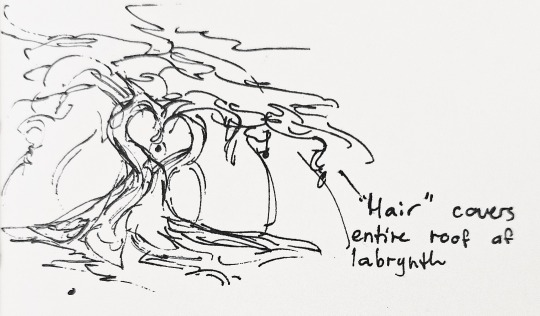
Honestly, the witches really feel like they could very much happen
Like, I've briefly considered Zhongli having a similar situation to Homura in this post instead of Istaroth. Not outright a witch but there are Signs and stuff. I could very much see him turning into Qinshihuang ngl
Rukkha could've become one either after Deshret died or if she hadn't gone through with her plan on destroying her soul gem while fighting Venti. The way Uma keeps building a paradise could be related to her wanting things to have gone differently with Deshret and Nabu, and if we go to the Venti route, it's her final thought about wanting her little sister Nahida to be born into a gentler world that affects her witch form.
She'd probably end up that way from exhausting all her magic in either situation. Like, the only reason she resorted to destroying her soul gem in the fight with Venti was to have enough power to kill every piece of his witch form through all the portals she has open in one shot.
As for Makoto, she could become one if Ei somehow dies again. I don't think she'd take it too well a second time. If we go by the events in the AU tho, it's more likely to happen if Venti hadn't killed her first. It's a slow build up from the week's events, like she literally watched Venti straight up drop dead in front of her, found out where witches came from, and had to force herself to keep it together while they dealt with the situation for days

Your description for her labyrinth and witch form made me imagine one made of tear stains and water damage and ink blots, perhaps even over a nonsensical map. Her obsession with going home could be her trying to get back to Ei. There's also faint whispers through the storm where one could hear faint murmurs about going home and "I'm all she has left"
Anyway yeah the AU brainworms sure is strong fjfgdjdvsnsx
13 notes
·
View notes
Text
This is one of the only terracotta warriors that was found almost completely intact. Note the detail on the bottom of his shoe, showing that grip and traction were considered in footwear even 2,200 years ago.
Each life-size clay warrior was crafted to be completely unique and there are no two terracotta warriors-among the 8,000 total-that are exactly the same.
Shortly after the completion of the tomb in 210-209 BC, it was looted for weapons and burned, causing the roof to collapse, crushing the terracotta warriors. All the other terracotta warriors that are currently on display were painstakingly restored. What's even more remarkable is that the terracotta warriors were originally painted in bright colors by skilled artisans.
Unfortunately, when they were exposed to air and sunlight during the excavation in the 1970s, the colors began to curl up almost immediately and disappeared within minutes.
These terracotta warriors were put in place to guard the tomb of the first emperor of unified China--Qin Shi Huang. To this day, the tomb has yet to be opened. According to ancient historians, the tomb contains an entire kingdom and palace in which the ceilings are decorated with pearls to mimic the night sky. The tomb is also said to contain extremely rare artifacts and has been rigged with crossbows to shoot anyone trying to break in. To keep its location a secret, the workers were entombed with the emperor.
The Han dynasty historian, Sima Qian, also mentioned that inside the tomb, "mercury was used to fashion the hundred rivers, the Yellow River and the Yangtze River, and the seas in such a way that they flowed." Modern tests have indicated extremely high levels of mercury in the surrounding soil.
#terracotta #warriors #unique #tomb #excavation #emperor #China #QinShiHuang #kingdom #handynasty #ancient #history #historical #historians

7 notes
·
View notes
Text
Only those who don’t know Chongqing well enough will call it a cyberpunk city. Beautiful city night views are not uncommon, and there are many cities that rely on inner harbors and mountains.
The best thing about Chongqing is its history. What dissatisfies me is that even some locals think it has no history. Although They have Qin Liangyu😶
Ba Qing was from Bajun (now Chongqing urban area). She was a wealthy businesswoman from the Qin Dynasty, helped Qinshihuang build the Great Wall and the Terracotta Warriors. Qinshihuang confiscated all weapons in the country, making him the only one with military force in the country. Ba Qing was an exception. She was allowed to have an army to protect her caravan. Her business gang had 10,000 employees and developed a pension system for employee.

When the Mongol Empire attacked the Southern Song Dynasty, the defenders of Diaoyu Fortress (now Hechuan, Chongqing) killed Mongke Khan. It divided the Mongol Empire internally and stopped its foreign campaigns. After Kublai Khan destroyed the Song Dynasty, the Mongols promised not to massacre the fortress, the defenders surrendered and committed collective suicide.

These fortresses held out for a third of a century, and the long war reduced the population of Sichuan (including Chongqing) from 1,2960,000 to 600,000. Four hundred years later there was another massacre of the same magnitude. This may be why we think we have no history.🤔
"Filling Sichuan with Hu-Guang people" was very important in shaping modern Sichuan. I always feel that I should find an opportunity to talk about this immigration movement.
I saw a map of cannibalism in China. It reflects the frequency of suffering in various regions of China.

(That is why I keep mentioning that Sichuan has experienced two genocides but still insists it is the most peaceful place in ancient China)
And this map shows that there are no cannibalism incidents in Guizhou and Taiwan. It is wrong. There was the Battle of Guiyang City in Guizhou. Guiyang City was besieged by ethnic minority rebels. Unlike the Siege of Suiyang, officials and literati committed suicide and gave their own meat to civilians. There was a fierce fight between the Han immigrants in Fujian and the Taiwanese indigenous, and the Taiwanese indigenous would chop off the heads of the immigrants. Immigrants will also kill the indigenous people to make a medicine called 番膏, which is used to treat diseases that "will be hunted by the indigenous".
5 notes
·
View notes
Text

This is one of the only terracotta warriors that was found almost completely intact. Note the detail on the bottom of his shoe, showing that grip and traction were considered in footwear even 2,200 years ago.
Each life-size clay warrior was crafted to be completely unique and there are no two terracotta warriors-among the 8,000 total-that are exactly the same.
Shortly after the completion of the tomb in 210-209 BC, it was looted for weapons and burned, causing the roof to collapse, crushing the terracotta warriors. All the other terracotta warriors that are currently on display were painstakingly restored. What's even more remarkable is that the terracotta warriors were originally painted in bright colors by skilled artisans.
Unfortunately, when they were exposed to air and sunlight during the excavation in the 1970s, the colors began to curl up almost immediately and disappeared within minutes.
These terracotta warriors were put in place to guard the tomb of the first emperor of unified China--Qin Shi Huang. To this day, the tomb has yet to be opened. According to ancient historians, the tomb contains an entire kingdom and palace in which the ceilings are decorated with pearls to mimic the night sky. The tomb is also said to contain extremely rare artifacts and has been rigged with crossbows to shoot anyone trying to break in. To keep its location a secret, the workers were entombed with the emperor.
The Han dynasty historian, Sima Qian, also mentioned that inside the tomb, "mercury was used to fashion the hundred rivers, the Yellow River and the Yangtze River, and the seas in such a way that they flowed." Modern tests have indicated extremely high levels of mercury in the surrounding soil.
#terracotta #warriors #unique #tomb #excavation #emperor #China #QinShiHuang #kingdom #handynasty #ancient #history #historical #historians
0 notes
Text
*Qin Dynasty* Emperor Qinshihuang's Mausoleum Site

The mausoleum site is the final resting place of Qin Shi Huang, the visionary leader who founded the Qin Dynasty (221–206 BCE) and laid the foundation for a united China. Known for his ambitious projects, the most iconic being the Great Wall, Qin Shi Huang's mausoleum is an architectural marvel that holds within its depths a treasure trove of history.
The highlight of the mausoleum is the world-famous Terra-Cotta Army, an army of life-sized clay soldiers, horses, and chariots created to accompany the emperor in the afterlife. Each warrior is unique, reflecting the incredible craftsmanship of ancient Chinese artisans. Witness the silent guardians standing in formation, frozen in time, a solemn testament to the emperor's quest for immortality. While the Terra-Cotta Army is a breathtaking sight, much of Emperor Qinshihuang's mausoleum remains unexplored. Rumors persist of a vast underground palace containing rivers of mercury, designed to mimic the celestial realm. Archaeologists are tirelessly working to uncover this hidden chamber, hoping to reveal more secrets of the emperor's vision for the afterlife.
Emperor Qinshihuang, who unified China in 221 BCE, envisioned an eternal resting place that reflected his imperial might. The mausoleum, covering a staggering 56 square kilometers, is a complex of subterranean palaces, ceremonial buildings, and the renowned Terracotta Army – an army of life-sized clay soldiers designed to accompany the emperor into the afterlife. The sheer scale and intricacy of the mausoleum are a testament to the technological prowess and organizational skills of the Qin Dynasty.
The Emperor Qinshihuang's Mausoleum Site stands as a living museum, preserving the legacy of a leader whose vision shaped the course of Chinese history. It invites travelers to marvel at the architectural wonders, ponder the significance of the Terracotta Army, and contemplate the enduring influence of a ruler whose mausoleum has become a symbol of ancient China's cultural richness and imperial glory. As you wander through this archaeological wonder, the echoes of a bygone era whisper tales of a once-mighty empire and its indomitable emperor.
0 notes
Text
SUDARSHAN LIVE KHABAR LOBBY
Sudarshanlive: 01/11/2022, international news updates, Report by – unesco,
Can you believe that this gigantic mausoleum was discovered by chance in 1974 and only became a #WorldHeritage Site in 1987? This incredible place — the Qinshihuang Mausoleum — is the tomb of Emperor Qin Shi Huang, founder of the first unified empire in Chinese history. The local farmers who came across pieces of a clay…

View On WordPress
0 notes
Text
¿Historias cortas para no dormir y así no tener pesadillas? Gran Muralla de Juyongguan
La Gran Muralla de Juyongguan debe su nombre al Paso Juyongguan, uno de los tres grandes puertos de montaña de la Gran Muralla (los otros dos son el Paso Jiayuguan y el Paso Shanhaiguan). Manteniendo una posición estratégica muy importante en la antigüedad como el punto de acceso directo del norte a Beijing, el Paso Juyongguan se construyó por primera vez en la dinastía Qin cuando el emperador Qinshihuang ordenó la construcción de la Gran Muralla. El paso actual fue construido en la dinastía Ming y fue renovado recientemente en 1992.

Ubicada a 60 kilómetros al norte del centro, la Gran Muralla de Juyongguan es la sección más cercana al centro de Beijing.
#La Gran Muralla de Juyongguan debe su nombre al Paso Juyongguan uno de los tres grandes puertos de montaña de la Gran Muralla (los otros dos#¿Historias cortas para no dormir?
1 note
·
View note
Text
yall wtf he’s so hot



19 notes
·
View notes
Video
Emperor Qinshihuang's Mausoleum Site Museum, China
#兵马俑#Terracotta#Army#兵馬俑#soldier#warrior#horses#cavalry#funerary#earthen#clay#ceramic#sculptures#Emperor#Qinshihuang#秦始皇#Qin#Shi#Huang#Mausoleum#Site#Museum#UNESCO#World#Heritage#Xi'an#西安#中國#China#中国
50 notes
·
View notes
Photo

#mask#masque#pandemic#virus#pandemie#qin#army#terracotta#china#art#funerary#emperor#qinshihuang#huang#shi#statues#sculpture#sculptures
18 notes
·
View notes
Photo

New Poll on Patreon: Ancient Maps! Vote for Augustus, Qin Shi Huang, Ramesses II, or Trajan on Patreon! https://buff.ly/2Og4ump Choose to have the maps go even further into the past to the foundation of the Roman Empire, the Chinese Empire, or even as far back as Ramesses the Great and New Kingdom Egypt! Or do you want to continue on with the Five Good Emperors and cover Trajan’s conquest of Dacia and invasion of Parthia? Join Omniatlas on Patreon to vote! Polls close 9 a.m. 1 December GMT. #ancient #ancienthistory #romanempire #ancientegypt #augustus #trajan #romanhistory #egyptianhistory #qinempire #chinesehistory #ancientchina #history #Patreon #omniatlas #ancientrome #romans #qindynasty #firstemperor #qinshihuang #ramesses #ramses #pharaohs #imperialrome #pharaoh #parthia #dacia #newkingdom #chineseempire #warringstates #maps (at Rome, Italy) https://www.instagram.com/p/B5Pedw4gvxh/?igshid=1284ihjq884wn
#ancient#ancienthistory#romanempire#ancientegypt#augustus#trajan#romanhistory#egyptianhistory#qinempire#chinesehistory#ancientchina#history#patreon#omniatlas#ancientrome#romans#qindynasty#firstemperor#qinshihuang#ramesses#ramses#pharaohs#imperialrome#pharaoh#parthia#dacia#newkingdom#chineseempire#warringstates#maps
1 note
·
View note